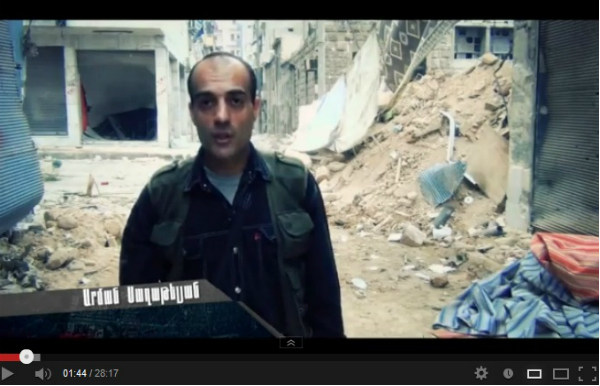The filmmaker of The Arab Spring’s Syrian Autumn, a short TV documentary broadcast on Armenia TV, has personally been in war-torn Syria and directed the film on the current state and issues of the Armenian community in Syria.
PanArmenian Media Group Deputy Director, journalist and writer Arman Saghatelyan went on the plane taking humanitarian aid to the Armenian community to Aleppo, where one of the largest, well-organized and self-sufficient Armenian communities live, their lives now full of unrest, pain, and daily struggles.
We, Armenians of Armenia, know very little about our compatriots in Syria, except perhaps from international news agencies’ video footage and official statements, which list the losses Armenian neighborhoods have incurred, the number of victims or the RA Ministry of Diaspora’s decisions welcoming (or not welcoming) Syrian-Armenians into Armenia. There came a time when the lack of our own produced reports on location on Armenian airwaves even became incomprehensible.
The Arab Spring’s Syrian Autumn (thus far only available in Armenian) attempted to fill that gap, being based on meditations and human destinies surrounded by the chaos of war, and documentary images caught by the filmmaker on the ground.
Saghatelyan, who’s used to working in war (generally, extreme) conditions, describes the project not as a welcome initiative but as an obligation. He says that the PanArmenian Media Group decided to absolutely have its own footage from Syria, but, when it came time to discuss who to send, serious issues arose.
“We couldn’t assume responsibility and without security guarantees send a journalist to a country where the situation is unpredictable. Of course, there were people who wanted to go (for example, experienced camera operators) but we didn’t take that risk (I would die from the strain till they returned). So it was decided that one of the company’s directors would leave for Syria. As they say, whatever will happen, let it happen to management. And it goes without saying that I myself very much wanted to make a film about the Syrian-Armenian community, stressing the immeasurable importance of this task,” he says, who is also the film’s camera operator.
Watching the film you feel that the Syrian-Armenian teacher, shopkeeper, or clergyman needs the attention of the media in Armenia, even if they’re not considering moving to Armenia and Armenia’s assistance isn’t a priority for them.
The Arab Spring’s Syrian Autumn first of all is valuable as a precedent. Of course, looking back, one might have wished the film had a stronger narrative structure or addressed in greater detail (even in text) the background to and course of the war, but the film is a complete Armenian TV production and proof — the need for which Armenian television has long felt.
It’s a precious TV attempt, the basis of which is the need to and gratification of getting information first hand (that gratification is simultaneously the viewer’s, the journalist’s, and the news outlet’s).
The documentary series, human relations, thoughts, the fear, details of everyday life, demolished streets, the church, and the mobilization of the community are scenes that describe us, which, apart from us [Armenians] no one else will shoot (that which another has shot, all the same, will speak on another’s behalf). While making a film with our own efforts and from our own point of view, you prove that you are the master of what happened. And you are the master of not only human destinies, but also the information about you in the news media, since you yourself are gathering, classifying, and disseminating the information.
“Why should we find out about our community from others? Where is our national information sovereignty? Perhaps it should be the opposite? Not us finding out from the Russians, but their finding out from us. I think, if we want, we can work quite well. And Syria is that country where we were obliged to go, to understand on the spot the situation and show the community,” says Saghatelyan.
For years, Armenian television has been satisfied with receiving second- or third-hand information and using that which another has filmed or photographed. But with this film, current documentary returned to the airwaves — as a precedent for now.
By the way, the issues of the Armenian community in Syria and Arman Saghatelyan’s work was featured in one of the Russia TV’s “News of the Week” program’s reports.
Nune Hakhverdyan







